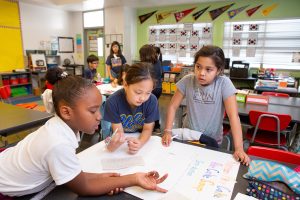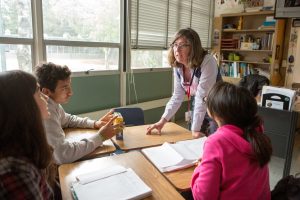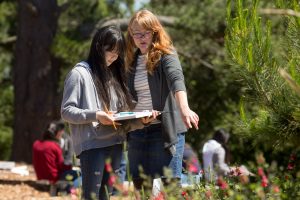1
Unlearning Box
“Those who can, do. Those who can’t, teach.”
“It’s easy to become a teacher.”
“Teaching is an 8:30-3:00 job. You have it so easy!”
You may have heard people in your own life share quotes and comments such as these. These quotes are hurtful and untrue. Teaching is a profession. Teachers are capable, intelligent, and held to extremely high professional standards. Quotes and comments like these demonstrate gross misunderstandings of what it means to be a teacher in the United States.
In this chapter, we will begin to peer behind the scenes of what it means to be a teacher in the United States. We’ll walk through a day in the life of a teacher, break down what is involved to become a teacher, and close with characteristics of effective teachers.
Chapter Outline
A Day in the Life
To get started, let’s drop into three different classrooms to get a feel for a day in the life of an elementary teacher, a secondary (high school) teacher, and a special education teacher.
Elementary Perspective
The school doors open at 7 AM, and you greet children as they enter the cafeteria for breakfast. Once morning duty is over, you hurry to your classroom to await the 25 students that will come filing in momentarily. You make sure materials and directions for tasks are ready and calming music is playing. As students enter, you gather signed forms and respond to notes from families, help students with their morning activities, take attendance, and hold a morning meeting. The rest of the day, you are simultaneously teaching the content areas–English, math, science and social studies–and social skills as students navigate groupwork and friendships. Various other educators drop in throughout the day: the reading specialist to work with a group of readers who need extra support, the occupational therapist to help a student with some motor skills still developing, the speech pathologist to help students with articulation and language development, the instructional coach and sometimes the principal to give you feedback on your instruction.

Pauses throughout the day from the busy pace of classroom life include related arts, where students go to learn about music, visual art, library, P.E., and more while you meet with your grade level for team planning; and lunch and recess, which involve scarfing down your lunch while getting your students through the lunch line, figuring out who changed their lunch choice or left their lunch at home, opening mustard packets, reminding students to eat while they talk with friends, and hopefully scuttling off to check your school mailbox and take a bathroom break. After a post-recess water break, you return to classroom instruction, with a few interruptions for students leaving early for doctor’s appointments, a student needing to go to the nurse’s office, another teacher popping in to borrow a book, or sometimes even a whole-school assembly for a class play or anti-bullying program.
When it is time to pack up for the day at 2:30, you make sure all students know how they are getting home that day, have their materials packed and ready to go, and then you bid them farewell at the door with a hug, high-five, or handshake as they head to their dismissal area. Once your room is empty, you go to monitor a dismissal area to make sure everyone is safe. After school, you might have a faculty meeting, a debrief with an instructional coach based on today’s observation, or time to prepare tomorrow’s instructional materials. You marvel at how quickly yet another day has passed in the life of an elementary school teacher.
Secondary Perspective
The bell rings at 8:15 AM, but you’ve already been at school for more than an hour–making copies, checking emails, and writing the plans and goals for the day on the board. As an English teacher, you’ve decided to work on writing fluency during this year, so as the students enter the classroom, they take out their journals and begin responding to the prompt on the board. Every day the class meets, the students will write for five minutes and then briefly discuss their responses with each other and as a whole group. You write alongside them to model what it looks like, and often share your own writing–at the beginning of the year, most of the students struggled to write for five straight minutes, but now nearly all of them have gotten the hang of it. The rest of the lesson involves a minilesson on figurative language, small group discussions about students’ literature circle books, and a whole group review game to prepare for the unit test on Wednesday.
The school adopted a block schedule last year, so your classes are 75 minutes long. You teach three of four blocks each day; today is an A day, so first block is 9th grade honors and the other two are 10th grade general English. Tomorrow, you will teach two blocks of 9th grade general and one block of 10th grade College Preparatory English. You hate these labels and what they do to the students in the room, and, as department chair, you have been working with your principal to remove such rigid tracking.

“Bear Block” falls between 1st and 2nd block, and ten students stream into the room to retake tests, make up missed homework, or just hang out and read. You glance at the learning management system and see that there are 45 essays waiting for you, but there won’t be time to look more closely at them until later tonight. During lunch, some of your journalism club students are in the room, partially working on stories and layouts, but mostly sharing the latest news about their friends and acquaintances.
For the Professional Learning Community (PLC) meeting during fourth block, you will meet with the other 10th grade English teachers to look at the results of a common assessment. At some schools in the district, the grade-level teachers all teach the same lessons, but luckily at this school you have more freedom in how you teach the material. There is a new teacher on the team who is struggling with classroom management, so the first 15 minutes of the meeting is spent discussing some strategies that have worked in other teachers’ rooms.
The end of the day comes at 3:15 PM, but it will be another hour or two before you head home–there are sub plans to finish for Thursday because you will be attending a district-wide training for working with English Language Learners, and you are hoping to send at least ten texts and emails to parents. The initial fear of parent contact faded quickly, and now it’s one of your strengths–you reach out early and often, connecting with families around student successes first. Later, if students begin struggling, contact is much more seamless. It’s been a long, exhausting day, but interacting with the students has made it all worth it.
Special Education Perspective
You arrive early in the morning, an hour or so before teachers officially start the school day. You greet the office manager, principal, and custodian on the way to your classroom. Aside from these three, the building will be mostly empty for another half hour. You’ve found that this quiet morning time provides the best opportunity to catch up on Individualized Education Plan (IEP) paperwork, reflect on student data from the prior day, and make adjustments to instruction for the coming day. As the official start time for the school day draws close, you make a quick dash to the copy machine, fingers crossed that it isn’t broken and that there isn’t a line of teachers anxiously waiting their turn. It’s your lucky day. Your last photocopies shoot out of the machine just as the overhead announcement calls teachers to report to their morning duty stations. You quickly drop the copies off in your classroom, pick up your data binder, and dash out the door to the bus loop.
The bus loop is a flurry of activity. You greet students with high-fives, occasional hugs, and countless reminders to “use walking feet.” Amid all of these informal greetings, you are slipping in some IEP services by completing morning check-ins with several students who have behavioral or social-emotional goals on their IEPs. From an outsider’s view, these check-ins don’t look that different from your interactions with any other student. However, intermixed with those high-fives and hugs you quietly assess needs, remind students of the goals they are working on, offer supports where needed, and quickly make notes in your data binder. On this particular day, a third grader with autism reports that he is feeling like “a category 3 hurricane.” You know he needs some quiet time before joining his homeroom class, so you walk him to the computer lab where he has an open invitation to help the instructional technology specialist get the computer lab set up for the day.
The halls begin to clear as the instructional day begins. You spend the next six hours in constant motion, serving 18 students across four grade levels. You transition between co-teaching in general education classes and pulling small groups of students to your own classroom for intensive intervention in literacy, math, or social skills. When co-teaching, your job is to supplement the general education teacher’s deep knowledge of grade-level content with specialized instructional strategies that make content meaningful and accessible for students with disabilities and other learning differences. When providing intensive intervention, you implement research-based programs that target specific skills identified in your students’ IEPs. Data collection is on-going and individualized for each student, so your trusty data binder is by your side in all settings.
Normally, you would end the school day completing check-outs with the same students you saw in the morning. Today, you assign that responsibility to a teaching assistant so you can participate in a special education eligibility meeting. It is the initial eligibility meeting for this student and her family. A team of educators work with the parents to determine if the first grader has a disability and needs special education. Her parents feel overwhelmed by the process and fearful when the team concludes that their daughter has an intellectual disability. This is a moment when your job and your passion meet. You assure the parents that the future is bright for their daughter, that the educational label does not change who she is or who she will be, and that you will highlight her strengths and address her needs as you plan her education with them as equal partners. The decisions that you will make with this family are new to them, but for you they are a familiar and important part of your day as an elementary special education teacher.
Characteristics of Effective Teachers
First of all, what does it mean to be an effective teacher? Effectiveness can be hard to define. Some ways to measure effectiveness include student achievement, such as test scores; performance ratings from supervisors, like administration members observing a lesson; or informal feedback in the form of comments from students or other stakeholders. Defining effectiveness is further complicated by the reality that there are many variables that a teacher cannot control that still impact these various measures (Stronge, 2018).
As you yourself have experienced as a learner, there are certain characteristics that effective teachers share. Even though all teachers have distinct personalities and instructional approaches that they bring to the classroom–since teachers, like students, are still individual people–here are some practices that effective teachers have in common.
Over the span of 15 years, Walker (2008) asked college students what made effective teachers in their own experiences and found twelve recurring characteristics.

- Prepared. Effective teachers were ready to teach every day and used time efficiently.
- Positive. Effective teachers were optimistic about their jobs and their students.
- Hold high expectations. Effective teachers believe everyone can succeed and challenge students to do their best.
- Creative. Effective teachers come up with new, innovative ideas to teach content.
- Fair. Effective teachers establish clear requirements for assignments, give everyone what they need to succeed, and recognize that learners are unique.
- Display a personal touch. Effective teachers connect with students by sharing stories about themselves and participating in their students’ worlds, like going to a performance or sporting event.
- Cultivate a sense of belonging. Effective teachers make students feel welcomed and safe in the classroom.
- Compassionate. Effective teachers are sensitive and empathetic to students’ situations.
- Have a sense of humor. Effective teachers bring humor into the classroom, but never at a student’s expense (i.e., laugh with, not at, students).
- Respect students. Effective teachers maintain privacy and don’t embarrass students in front of the class.
- Forgiving. Effective teachers don’t give up on students and start each day without holding grudges about how previous days have gone.
- Admit mistakes. Effective teachers apologize when they make mistakes and make adjustments accordingly.
In addition to these personal qualities, there are specific ways to structure learning that are more effective than others. Creemers and Kryiakides (2006) called this the “dynamic model of educational effectiveness.” The dynamic model focuses more on teaching and learning than other factors that are beyond the teacher’s control in the classroom. Eight factors that tend to have an impact on student learning are explained in Table 1.1 (adapted from Muijs et al., 2014).
Table 1.1: Eight Factors that Impact Student Learning (Muijs et al., 2014)
Factor |
Examples/Elements |
| Orientation |
|
| Structuring |
|
| Questioning |
|
| Teaching modeling |
|
| Application |
|
| The classroom as a learning environment |
|
| Management of time |
|
| Assessment |
|
As you can see, while we all bring our own personalities to our own classrooms and instruction, there are some practices that have consistently impacted student learning. We will continue discussing those specific practices throughout the rest of this book, and you will continue honing those skills as you continue on your pathway toward becoming a teacher.
InTASC Standards
Common characteristics of effective teachers can be found in ten InTASC standards. A nonpartisan, nationwide group of public officials with leadership positions in U.S. K-12 education called the Council of Chief State School Officers (CCSSO) created a subgroup called the Interstate Teacher Assessment and Support Consortium (InTASC). InTASC created a list of ten standards that cover model core teaching practices that high-quality K-12 teachers should be able to demonstrate as effective teachers. These standards were originally released in 1992 to guide early-career teachers, but the group realized that these characteristics were actually applicable to all teachers. Therefore, in 2011, InTASC revised the standards and expanded them to all teachers. Table 1.2 breaks down the 10 standards into the four overarching categories.
Table 1.2: InTASC Standards by Categories
| The Learner and Learning
This category recognizes that before we can teach, we must understand our learners.
|
| Content Knowledge
This category focuses on the depth of knowledge teachers need to possess in their corresponding content areas in order to support students in their accurate learning of content.
|
| Instructional Practice
After mastering the content knowledge itself, effective teachers need to understand how to deliver instruction by weaving together assessment, planning, and instructional strategies.
|
| Professional Responsibilities
In this category, a teacher’s role as a life-long learner is the focus. Learning can occur through professional development (like trainings and classes), reflection, taking on leadership roles, and collaborating with various stakeholders.
|
Professionalism & Dispositions
The last category of InTASC standards focuses on professionalism. Teachers are held to very high standards as professionals because of their influence on shaping students’ learning, outlook, and futures. Teachers are expected to be role models, both within and beyond the classroom. Therefore, there are certain interpersonal skills–sometimes called dispositions–that teachers are expected to demonstrate as professionals.
A challenge related to dispositions is that research has not yet established an exact set of non-academic qualities that teachers need to demonstrate in order to be successful (CAEP, 2020a). Therefore, expectations of which dispositions should be observed will vary. Overall, here are a few examples of dispositions that you should possess as a future teacher.
- Communication. You will be expected to demonstrate mastery of oral and written communication with a variety of stakeholders, including students, co-workers, administration, and families. Communication should be respectful and positive, and teachers are often expected to demonstrate mastery of conventions of standardized English.
- Professional image. Related to communication, you are expected to portray a professional image in words and actions. You will be expected to dress professionally. You will be expected to avoid documentation of overly reckless behavior, such as photos on social media of drinking to excess at a party. As a teacher, you are a representative of your school district, and you are expected to maintain that professionalism within and beyond the classroom.
- Organization. While there is no one “correct” way to be organized, you will be expected to manage your time, complete tasks by deadlines, and show up to work on time. You will also need to be able to organize student records (including assessments) and return assignments to students in a timely manner.
- Collaboration. You will be expected to collaborate with a variety of stakeholders, including students, co-workers, administration, and families. Many times, you will be interacting with people whose backgrounds differ from your own, and it is very important that you respect the contributions of others, even if you would not approach a situation in exactly the same way.
- Reflection. You will be expected to reflect on your instructional practice and adjust your next steps accordingly. Rarely does an instructional activity go perfectly, and that’s OK! Teachers must be able to reflect on what went well and what to change going forward.
Critical Lens: Linguicism
You’re heard of lots of -isms: racism, sexism, classism. What about linguicism? Fain (2008) cites Skutnabb-Kangas (1988) to define linguicism as “unequal treatment of languages based upon power structures that privilege certain languages as having legitimacy” (p. 205). People often assume that “Standard English” is right and everything else is not (Wheeler & Swords, 2006). Standardized English received this position as a “prestige dialect” (Wheeler & Swords, 2006) about 500 years ago, when the self-declared “superior” Europeans came to the Americas and began interacting with the so-called “inferior” native people. Linguistic discrimination, therefore, is a result of the “racist project of colonialism” (Otto, 2004, p. 3). Linguicism can be applied to languages, such as Spanish, or dialects, such as African American Language or Southern English. As Wheeler and Swords (2006) remind us, “while language varieties clearly differ, difference does not signal deficit” (p. 14). (Note: We use the term “Standardized English” instead of “Standard English” to highlight the artificial construction of one language as the “standard” and all others as “substandard” [Wheeler & Swords, 2006].)
Many of these dispositions and expressions of professionalism are culturally bound. For example, tattoos may need to be covered in some school districts, while others do not mind if age-appropriate tattoos are visible. It is important to know the expectations within your local context so that you can act accordingly. In Chapter 5, we will discuss more about your legal and ethical protections and expectations as a teacher.
Teacher Beliefs

In the teaching profession, it is also important to be aware of our beliefs. Awareness of our own beliefs can be particularly challenging because sometimes we are socialized into certain beliefs and do not even realize we hold them until we meet someone who holds different beliefs. Furthermore, in education, “Whiteness is the invisible norm” (Derman-Sparks & Ramsey, 2006, p. 35). As we established earlier in this chapter, most teachers in the United States identify as White. That means that the majority of teachers share certain aspects of mainstream cultural backgrounds and bring them into their schools and classrooms, often teaching next door to other teachers who share those same mainstream cultural backgrounds. That is how one cultural background can become the invisible norm.
We teach who we are. We bring our identities into our classrooms on a daily basis, just like our students do. Who we are involves many different facets of our identity, called intersectionality. Legal scholar Kimberlé Crenshaw (1989) invented the term “intersectionality,” and it has since been applied in varied contexts, including education. The idea behind intersectionality is that many different aspects of our identity–including characteristics such as race, economic class, gender, and more–overlap and “intersect” with one another. Our identities–and our students’ identities–are greater than any one isolated characteristic.
As human beings, we have a natural desire to belong in order to survive. This drive to survive results in our grouping people–both consciously and unconsciously–based on their similarities or differences to us. Unfortunately, those same survival skills mean that we may think less of people who are different from us. We may think they aren’t as smart, or aren’t as good at what they do, or don’t do things the “right” way (the way we do them). Judging or evaluating another culture based on your own culture is called ethnocentrism. If we aren’t careful, we can let ethnocentrism interfere with our professionalism as teachers. We might think a student is less capable of success in our classrooms or beyond based on our own cultural beliefs about certain characteristics. Sometimes we assume people from certain racial, socioeconomic, ability, and other demographic groups are less capable, simply because of our own expectations or cultures. We might consciously or unconsciously believe certain stereotypes–sweeping, oversimplified generalizations about a group–and those stereotypes will filter into our interactions with our students, our expectations of our students, and our teaching in general. As Gorski (2013) reminds us, “no amount of resources or pedagogical strategies will help us to provide the best opportunity for low-income students to reach their full potential as learners if we do not attend first to the stereotypes, biases, and assumptions we have about them and their families” (p. 69).
Therefore, an important aspect of being an effective teacher is knowing yourself. Freire (1973) discussed the importance of critical consciousness, the ability to see beyond one’s own limited realm of experiences. Members of mainstream groups must be especially aware of their identities and how these identities impact their teaching (Gay, 2010; Harro, 2000).
Conclusion
In this chapter, we surveyed the teaching profession in the context of the United States. You learned that teachers today are mostly White females with 10-20 years of experience in the classroom. Pathways toward preparing high-quality teachers can be traditional, such as earning an undergraduate or graduate degree in education, or alternative, such as provisional certification or residency programs like Teach for America. No matter how you earn your initial teaching license, you will need to renew it periodically. Finally, the teaching profession depends on characteristics of effective teachers. InTASC standards remind us of ten common characteristics of effective teachers across four domains, and dispositions relate to our general professional demeanor as teachers. Additionally, we must be aware of our beliefs and how they consciously and unconsciously contribute to our instruction. In the rest of this book, we will continue to explore the complexities of the teaching profession.
Framework designed by Benjamin Bloom and colleagues in 1956, and later revised in 2001. Divides educational goals/cognitive processes into six categories of increasing complexity: remember, understand, apply, analyze, evaluate, and create.
10 standards from the Interstate Teacher Assessment and Support Consortium that cover model core teaching practices for K-12 educators.
Interpersonal skills expected of teachers as professionals.
Unequal treatment of languages based upon power structures that privilege certain languages as having legitimacy.
Term coined by Crenshaw (1989) meaning many different aspects of identity--including race, economic class, gender, and more--overlap and intersect with one another.
Judging or evaluating another culture based on your own culture.
Sweeping, oversimplified generalizations about a group.
